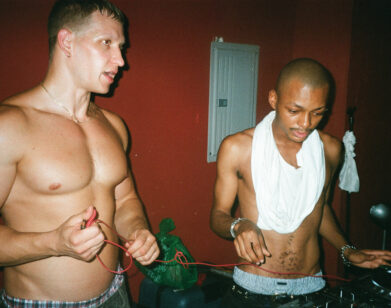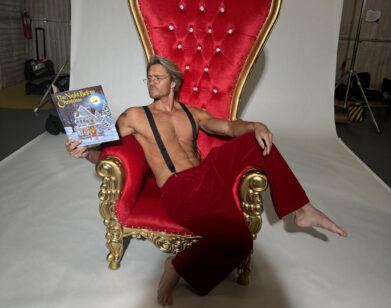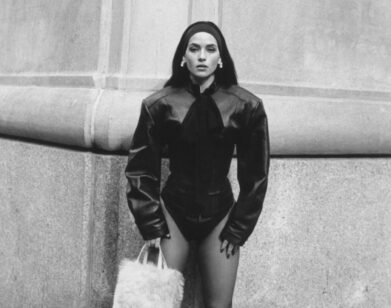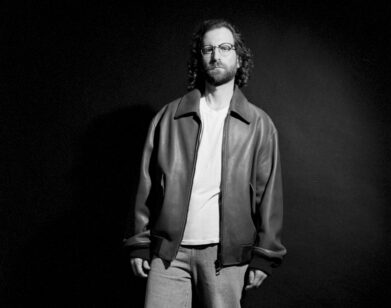Todd Haynes’s First Love Story
Carol, the new film from director Todd Haynes, is bookended by the same scene: two women having drinks at The Ritz in 1950s New York, when a man interrupts them. The first time, we experience it through the perspective of the younger woman, Therese (Rooney Mara). We feel the worldly glamor of her companion, Carol (Cate Blanchett), and Therese’s disappointment when she stands up to leave. By the end of the film, however, we are with Carol and it is Therese who is aloof.
Co-starring Kyle Chandler as Carol’s husband Harge, Sarah Paulson as Carol’s oldest friend Abby, and Jake Lacy as Therese’s boyfriend, Carol is based on the novel by Patricia Highsmith and was adapted for the screen by Phyllis Nagy. At its core, Carol is a love story, and Haynes considered classic films such as Brief Encounter, Letter from an Unknown Woman, Rebecca, Now Voyager, and The Lovers in his approach. “Those are the ones that really were marked by a disempowered subject,” he says. Carol and Therese’s relationship is one overwhelmed by obstacles and boundaries—societal norms and stifling post-War promise—introduced in the opening frame of a sewer grate and echoed throughout the film in Haynes’s shots through windowpanes and other “obstructions.”
Last week in New York, we spoke with both Haynes and Chandler about the film. To skip down to Chandler’s interview, click here.
EMMA BROWN: This is you first time working with a pre-existing script. What was that experience like?
TODD HAYNES: I had a great experience. I worked on the script with Phyllis when I came on board and there were some changes that we made together. We stayed conversant throughout the shooting process as well. For the most part it wasn’t that different except I didn’t have that long, private period with the material. But once you are shooting a movie, even if it’s your own script, you have to let it go at a certain point. That’s true for every film. It breaks up into phases where the thing that you have in front of you is the thing you have to address, and you can’t worry about what you imagined a scene was going to like and that it came out differently, because that’s what you have, and that’s what you have to make work. That’s true with successive cuts of the film and reactions that you get from viewers who are watching your cuts and all those things.
BROWN: I know you generally do a huge amount of research for your films. Did using a pre-existing script affect the amount of research you did?
HAYNES: Only in the amount of time. It wasn’t quite as much time as I usually take, but I still had a good amount and I still put a lot of time and thought into my image book. That’s the way I begin to really make it into a visual experience that I can start to share, first with my director of photography, then the production designer, the costume designer, even the actors. I always share those visual elements with everybody involved. It informs everybody in ways that you can’t necessarily identify. I hear Cate and Rooney talking about that image book and how it helps them to see the language of the movie—[the images] tell the actor who’s looking at who and what side of the gaze are you playing to, and that informs how they play it.
BROWN: I wanted to talk about the opening shot of the sewer grate. The grate is very beautiful and it looks sort of like a majestic wrought iron gate at an old-fashioned train station until you see the context. What made you decide to start with that shot? Was it difficult to find the right grate?
HAYNES: We found grates that were really in Cincinnati, but they weren’t in exactly the right place for the shot, so that one we actually brought ourselves. It was a complicated shot in all regards because we had a crane on a vehicle, which ultimately had to go down the street and turn around the corner. For us that was a big deal and took a lot of time, but it was beautifully orchestrated by everyone involved. Jesse Nye, my assistant director who directs the extras in the cars, did a masterful job with squeezing those numbers so it looks more busy than it actually was.
BROWN: How abstract do your image books get?
HAYNES: It goes thematically. Some pages are arranged based on color palette, so it’ll be all of the shots of New York City from a handful of photographers in color whose palettes all speak to each other. It’ll be the page of weird puce yellows and soil purples. Then there will be a page of New York in the snow, a lot of Saul Leiter classics from that period, but other photographers as well—[André] Kertész was a beautiful color photographer and then all those women [photographers] that we kept finding. I do a lot of frame grabs from specific films that I’m thinking about or referencing. Sugarland Express, the Spielberg film from the ’70s, which is so beautifully shot in terms of the use of natural light and the camera work inside of the moving vehicles, was something that I paid a lot of attention to. I know [cinematographer] Ed [Lachman] was a little like, “Sugarland Express? That’s not on the same level as L’Eclisse by Antonioni,” which was also in there, but all that stuff is relevant.
BROWN: I heard that for Far from Heaven you put specific colors on each page of the script to mark the mood of each scene.
HAYNES: Yeah, Far from Heaven had a really meticulous and sort of insanely detailed color chart process per scene. I didn’t do that for Carol. It wasn’t quite necessary and the colors were not expressionistic the way they are in Sirkian melodrama, so they all fall into a more uniform language. The colors in Therese’s apartment and Carol’s house were not going to visibly clash and scream at you and tell you that these are different economic worlds. In a sense, the whole world that they’re in has a similar kind of distress to it.
BROWN: I was having an argument with someone about whether Carol or Therese is the protagonist of the film…
HAYNES: Who won? [laughs]
BROWN: I initially thought was Therese—my friend thinks it’s Carol—but now I feel like there’s that pivoting point in the film where it switches from Therese to Carol.
HAYNES: I definitely feel that there’s a pivoting point. We’re not as anchored in Carol’s view of Therese until privileged moments later in the movie. To me, the most memorable is when Carol is in the cab on the way to the lawyer’s office and she spots Therese in the streets of New York on her way to work. Therese doesn’t see Carol and Therese looks more like Carol than she ever has, but she’s occupying her place in the world. That’s where the poles have really, really shifted; it makes you think about all the ways Therese used to see Carol in the world. There’s nothing more cruel than when you look at your object of desire, or your once-object of desire, and they have forgotten that you exist.
I love that it’s really the person who is in harm’s way who is the subject, and that’s how it’s defined. I think it’s really interesting that that’s who you’re rooted with. In male-driven [films], the protagonist is not the person who’s necessarily in harms way. There’s a sense that they’re going to figure out how to persevere and take on the obstacles and foes and you don’t necessarily know if that’s going to happen with the subjects of love stories.
EMMA BROWN: I know Todd gave Rooney films and music from the time period. Did he do the same for you?
KYLE CHANDLER: Not movies that I recall. But he me gave music of the time, a substantial amount of it as well. It’s varied music throughout. It made me curious because it was a little hollow; there was a bittersweet sadness to it, a nostalgia. Nostalgia could be considered a disease because you’re living now. It was an odd feeling of variety of music.
BROWN: Todd has a reputation for being a very visual director. Sandy Powell, the costume designer, mentioned that both Todd and Martin Scorsese understand the aesthetics of film in a way a lot of directors don’t. Was that your experience?
CHANDLER: Todd’s the type of director, like some of the others you’ve mentioned that I’ve gotten a chance to work with, that can come up to you and say one word and you get it, because he knows everything that’s going on. He’s very, very intelligent. He’s all around. He knows what he wants and when he comes to the actor and says what he needs, his short little bit of information is more than enough to get you where you need to go. He’s also a very good leader—[it was a] very calm set. It’s a pleasure to work with him. It was fantastic. My part in this film is a tricky little part and he knew exactly what he wanted and I brought my part and it just worked.
BROWN: I found Harge quite sympathetic, even though he’s an obstacle in Carol and Therese’s relationship. You understand how devastating it is for him.
CHANDLER: Yeah, we’ve all been through it where we love the other person and we’re not loved back. It was a really complex character to play. There are so many things involved in this. It’s the 1950s and you have a very wealthy man who has his estate and his parents, who have their thumb on him a little bit. He has authority in his world and yet there’s this thing going on, which is just unheard of, un-talked about. So he has to live a double life knowing what’s going on with his wife and trying to quell that. On the outside world, certain friends and such, whether he knows they know or not, there are murmurs. He’ll do anything to get his postcard picture life back again: “I want my wife, I want my child, I want my family, I want my American dream.” Even though his American dream is a dream. [But] I found that he did love the woman enough, does love the child enough, does love the child’s future enough, and does have enough respect for himself, and for her, to not destroy everything. Maybe it’s an intelligence, maybe it’s a backlash from his parents, but at some point he can realize, “This is what it’s going to be.” That’s what the end of the film, I thought, was for Harge. He could have died literally in the last seconds of the film, or he could have, in essence, been reborn.
BROWN: Do you think that Carol and Harge were ever happy?
CHANDLER: Yes, most definitely. He was very in love. I don’t know what happened. We don’t see that part of the story, but as I played the role I could see in Carol’s face that she knows she hurt me. We were very much in love—I was with her.
BROWN: Harge must have been in the War. Did you think about that at all?
CHANDLER: Yeah, we did talk about that. I usually draw up a background of the character. I don’t tell anyone, it’s my own little deal, but I did put him in—he did see some kind of confrontation of the battlefield. You speak to soldiers—maybe you have friends that have been to Iraq or Afghanistan; I have a lot of them—and there’s a quiet stillness to them. You just know a soldier when you seem them; you notice it in their eyes. For me, I thought that was a good place to be because he did have a violence where he could, and may have, in his past, taken a life. That violence is something, as an actor, that I would always keep down and have to fight—another obstacle. There’s a certain amount of manliness that comes from—in my imagination, you come home and then your wife is leaving you for another woman, what would people say? There’s that illness upon you. Yeah it’s complex, he’s like the hero that’s just lost everything in a sense, in my mind. That’s the character I created.
BROWN: Did anything surprise you when you saw the film, or did it feel like the film you made?
CHANDLER: It’s been a while, but it felt like the film that I worked on. It’s a powerful little movie. No, I wasn’t surprised. I was pleasantly surprised. There’s your quote. [laughs]
CAROL IS IN THEATERS NOW.







